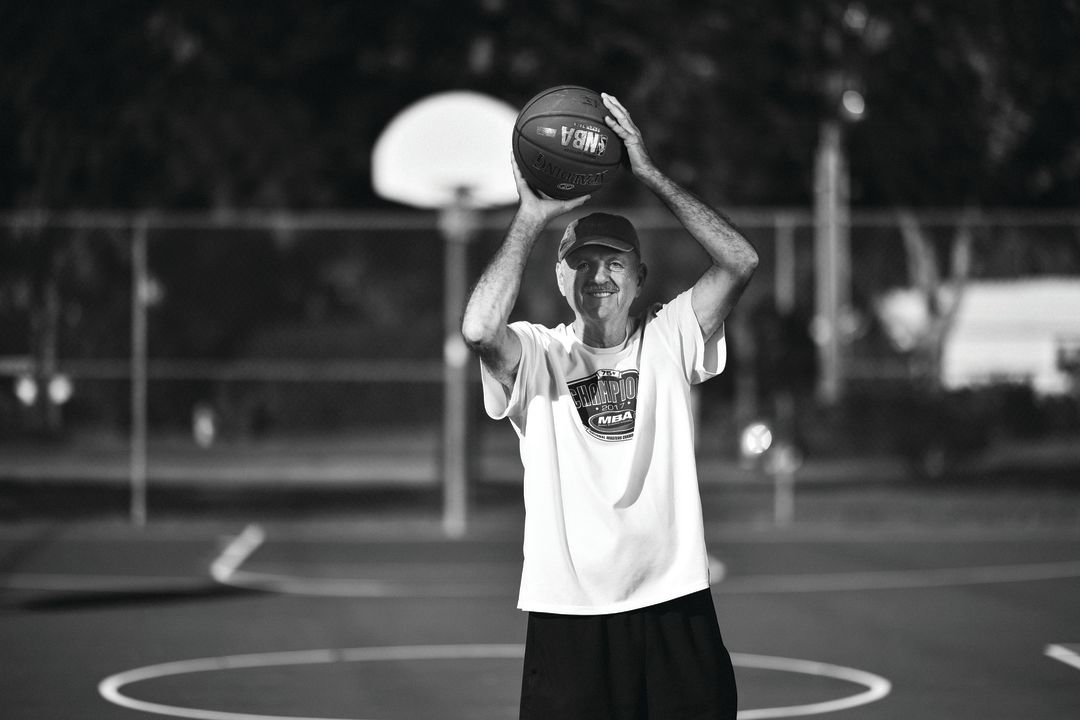Senior Athletes are Redefining Aging

At 78, Sid Holtzer still rules the basketball court.
Image: Everett Dennison
On a recent morning pickup basketball game at Arlington Park, Sid Holtzer caught a pass near the foul line, head-faked his opponent, took two dribbles to his right and swished a game-winning shot. It was a fine play for any player, but what made it remarkable was that Holtzer is 78 years old and was playing with players decades younger.
Holtzer played for Hofstra University and, after that, never stopped competing recreationally, even when he was working for IBM and living in Paris. “No way did I expect to still be playing at 78,” he says. “But I’m so glad that I have. It remains a great part of my life.”
Holtzer is among a growing number of senior athletes, including runners, swimmers, cyclists and even triathletes, who are redefining aging. Many will be participating Feb. 11-18 at the 29th Annual Gulf Coast Senior Games. In basketball, Holtzer says, the 60-and-over age group used to seem the outer limits. Today, the national senior championships have added an over-80 full-court division. “There are more players at that age who want to keep competing,” he says.
Heather Vincent, director of the University of Florida’s Sports Performance Center, says research involving senior athletes is rapidly advancing. “We’re working with one runner who is 85 and still going strong. Unless you have specific restrictions from your physician, there is no reason to stop training and competing,” she says. “We’re seeing these athletes do things that previous generations might not have thought possible. They are changing the trajectory of aging.”
Look at the national records by age group compiled by USA Track and Field. Among the 43 events for athletes 35 to 39, only about half the record performances have come since 2000. But in the men’s age 70 to 74 division, records in 31 of the 35 events have come this century. In the women’s 70 to 74 age division the evolution is even more startling: Every single record, from the 100-meter dash to the decathlon, has been broken in the past 15 years, most in the past five years.
The same is true in swimming. In June, 90-year-old Jean Troy, competing for the Sarasota YMCA Sharks Masters swim team, shattered four world records in her age group (90 to 94) in a single meet.
Troy has been active all her life, but, she says, “I didn’t start getting serious until about 20 years ago, and I didn’t start setting records until I was 75. It keeps me going.”
Nancy Downs still has plenty of years ahead of her. At age 71, the Venice resident last spring completed her second ironman triathlon, which starts with a 2.4 mile swim, followed by a 112-mile bike race, and concludes with a marathon run of 26.2 miles. Downs runs with the Manasota Track Club and works out six times a week, many days with a trainer.
“It’s just a lot of fun,” says Downs, who has run 111 marathons. “You meet so many great people. My body feels really good.”
Holtzer is quick to dismiss skeptics who say that senior athletes can compete only because they are genetically blessed with age-defying bodies that most people could never match no matter how hard they trained.
“That’s just not true,” Holtzer says. “My father died at 50 of a heart attack. My brother died of a heart attack at 39. I was always scared it would happen to me, so I kept exercising and tried to eat a good diet.”
Genetics do matter, says Vincent, the University of Florida researcher: They affect 40 to 80 percent of a person’s ultimate capabilities. And aging takes a toll, each year stealing another slice from a person’s muscle mass and maximum oxygen consumption. But researchers are finding that the right kind of training enables seniors to keep competing well into their later years.
While walking 20 minutes a day at a brisk pace is “still fantastic,” Vincent says, what really boosts conditioning is high interval training. That involves eight to 10 low or moderate intervals combined with 30-second bursts of maximum effort. “We’ve found that this pays off more than even 45 minutes of sustained moderate exercise,” she says.
Another key to staying competitive, Vincent says, is strength training, such as lifting free weights two or three times a week. Such training fights the natural loss of muscle mass and strengthens the muscles around the joints to help prevent injuries. And athletes who regularly strength train have better posture and form in their sports, which allows them to perform more efficiently. Balance training and diet are two other elements that make a huge difference, she says.
“I don’t know what the physiological ceiling is for older athletes,” Vincent says. “We’re learning more all the time. We’re seeing 85-year-olds run marathons. It’s inspiring what these athletes are doing.”



